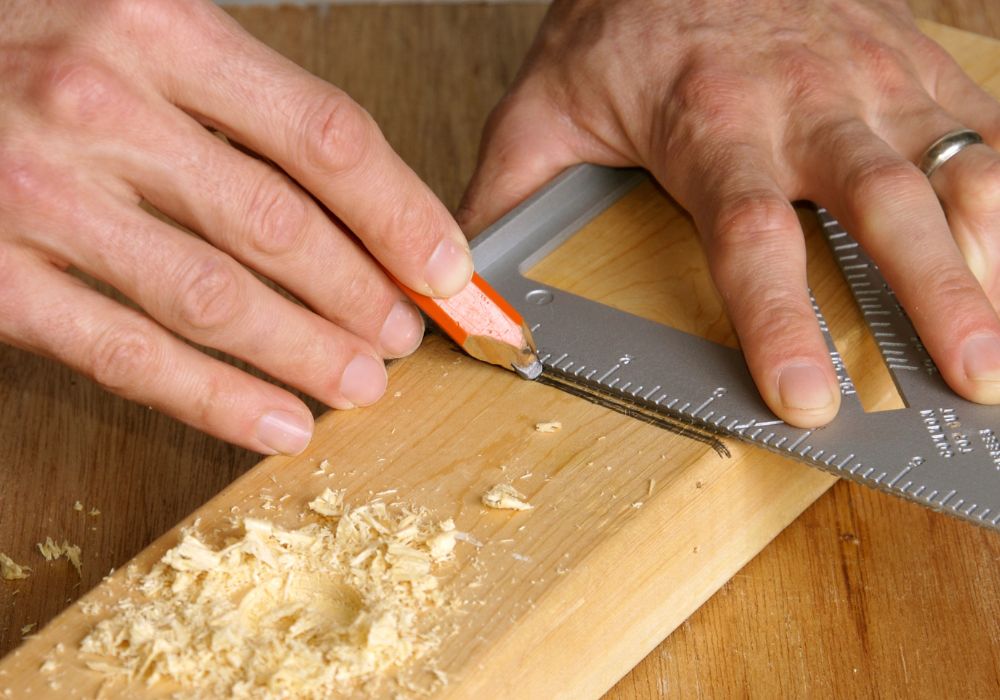Both professional and do-it-yourself carpenters will find a speed square, also called a rafter square or triangle square, indispensable. From directing saw cuts to marking exact angles, its adaptability and simplicity make it indispensable for many jobs. Knowing how to best use a speed square can help your projects be far more accurate and quality.
Contents
Understanding the Speed Square
The speed square, also called a rafter square or triangle square, is a triangular-shaped tool that combines the functions of a protractor, ruler, and try square. It is a staple in carpentry and DIY projects, prized for its versatility and precision. Typically made of aluminum or plastic, this tool is lightweight yet durable, designed to withstand tough working conditions.
Key Components of a Speed Square
- Hypotenuse Edge: The longest side of the triangle, often used for marking and as a straightedge.
- Pivot Point: Located at the corner where the hypotenuse meets the right angle, this serves as the base for measuring and marking angles.
- Ruler Scale: The flat edge of the square has inch or centimeter markings, making it useful for measuring lengths.
- Degree Scale: The inner edge features a protractor for finding and marking precise angles.
- Scribe Notches: These are small cutouts along the ruler scale, perfect for quickly marking parallel lines.
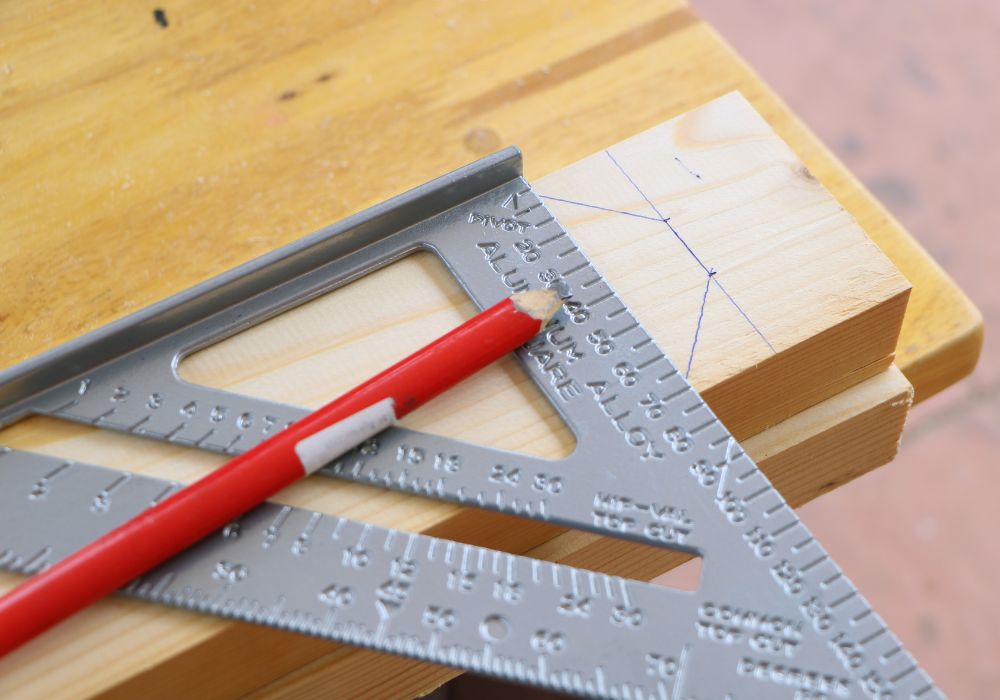
Why It’s Essential for DIY Projects
The speed square simplifies many tasks by combining multiple tools into one. It ensures straight cuts, precise angles, and accurate measurements, whether you’re building furniture, framing a structure, or creating intricate woodworking designs. Its intuitive design makes it easy for beginners to use while offering advanced functionality for seasoned DIYers.
Understanding its components and purpose is the first step to leveraging the speed square’s full potential in your projects.
Basic Uses of a Speed Square
A speed square is more than just a simple measuring tool. Its design allows for a range of applications, from marking perfect angles to acting as a cutting guide. Learning how to use a speed square effectively can elevate your DIY skills, ensuring your projects are precise and professional. Below are the basic uses of a speed square and how it can simplify your tasks.
Marking 90-Degree and 45-Degree Angles
One of the most common uses of a speed square is marking right angles and 45-degree angles. To mark a 90-degree angle, place the square’s lip against the edge of your material. The straight edge will align perfectly with the surface, giving you an accurate guide for cutting or marking. For a 45-degree angle, rotate the square until its angled edge aligns with the material, then mark along the hypotenuse.
This feature is especially useful for framing, creating picture frames, or any project that requires precise corner joints.
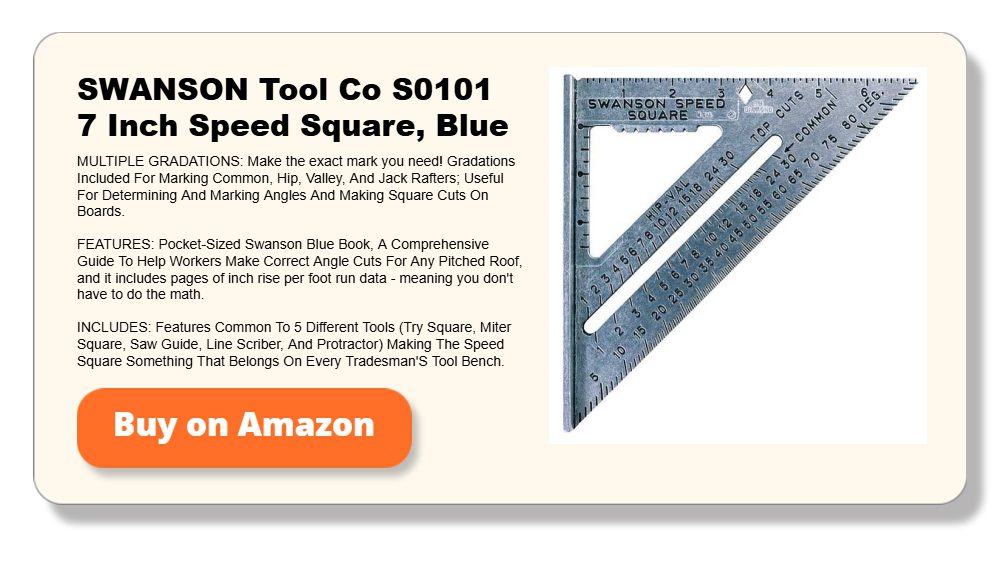
Drawing Straight Lines
The speed square doubles as a ruler for drawing straight lines. Use the edge of the square to extend cut lines or guide measurements. This is particularly handy when you need to ensure consistency across multiple pieces of wood.
For longer materials, you can slide the speed square along the edge while maintaining alignment, ensuring the line stays true from start to finish.
Serving as a Saw Guide
A f is a valuable tool when cutting wood with a circular saw. Align the square’s edge with your cutting line and hold it firmly against the material. The lip of the square ensures it stays steady, while the straight edge provides a guide for the saw blade.
This technique prevents uneven cuts and helps maintain straight edges, which is essential for projects like shelving, furniture building, and framing.
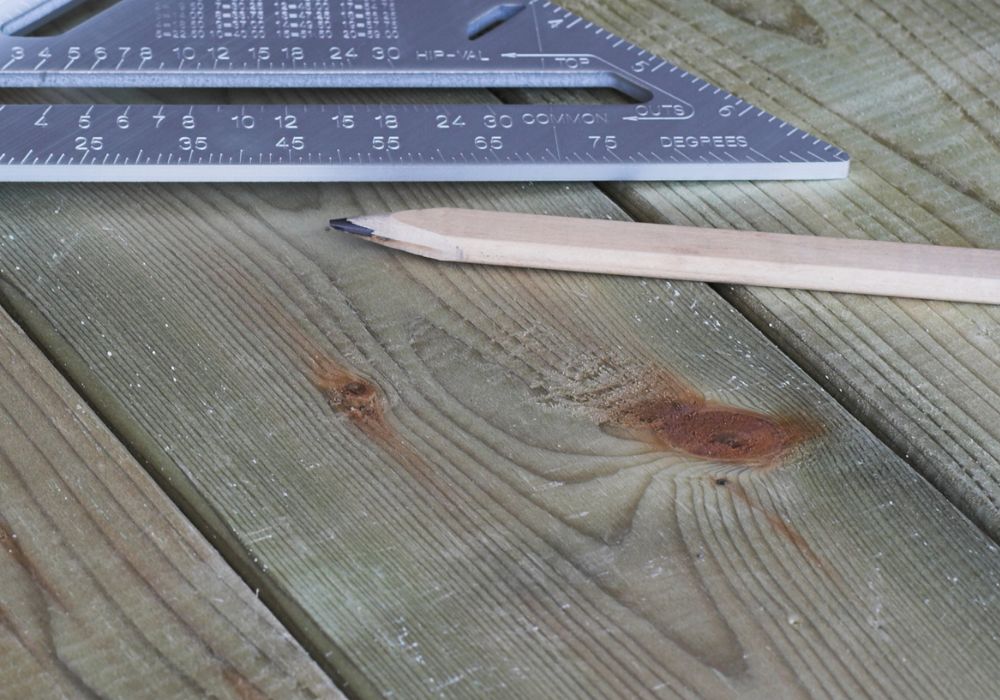
Measuring and Marking Angles
Beyond 90 and 45 degrees, a speed square can measure and mark custom angles. To do this, locate the pivot point and align it with the material’s edge. Then, use the degree markings on the hypotenuse to find your desired angle. Once the square is positioned, mark the angle along the edge.
This feature is crucial for tasks like constructing roof rafters or designing geometric patterns in woodwork.
Determining Roof Pitch
The speed square is often used in roofing to calculate pitch. Roof pitch refers to the steepness of a roof, typically expressed as a ratio. To measure this, place the square’s lip against the roof’s edge and use the degree scale to find the incline.
Accurately determining pitch is vital when designing or repairing roofs, ensuring structural integrity and proper water runoff.
Laying Out Stair Stringers
Creating stair stringers can be a challenging task, but a speed square simplifies the process. Use the square to mark the rise and run of each step. Align the square’s lip with the edge of the wood and use the markings on the ruler scale to measure each step’s dimensions.
By repeating this process across the length of the stringer, you can create consistent, sturdy steps for any staircase.
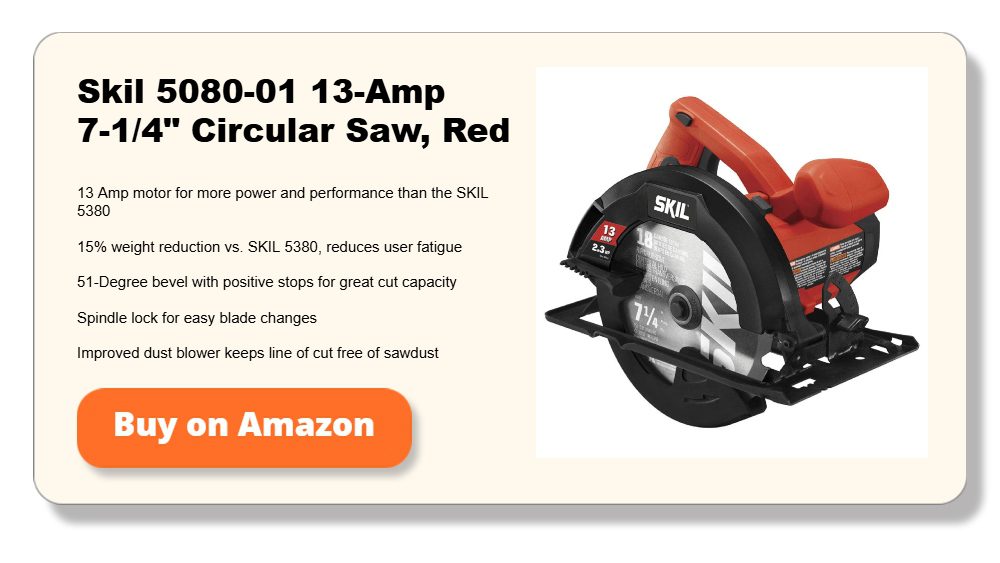
Making Pocket Hole Jig Setups Easier
When using a pocket hole jig for joinery, a speed square can ensure your setup is precise. Before drilling, use the square to confirm that your material and jig are aligned at a perfect 90-degree angle. This alignment is crucial for strong, professional-quality joints.
The speed square also helps verify that the pocket holes are evenly spaced, which is key for aesthetics and structural stability.
Scribing Parallel Lines
Scribing lines parallel to an edge is effortless with a speed square. Many squares feature scribe notches along the ruler edge. Insert the point of your pencil into the desired notch, then slide the square along the material’s edge while keeping the pencil steady.
This method is ideal for tasks like marking wood for rip cuts or creating decorative grooves in your projects.
Checking Material Squareness
A speed square can quickly verify whether a material is square. Simply place the square’s lip against one edge and check if the other edge aligns with the hypotenuse. If there’s a gap, the material may need adjustment to achieve a true square.
This is an important step for projects like building frames, cabinets, or doors, where precision is non-negotiable.
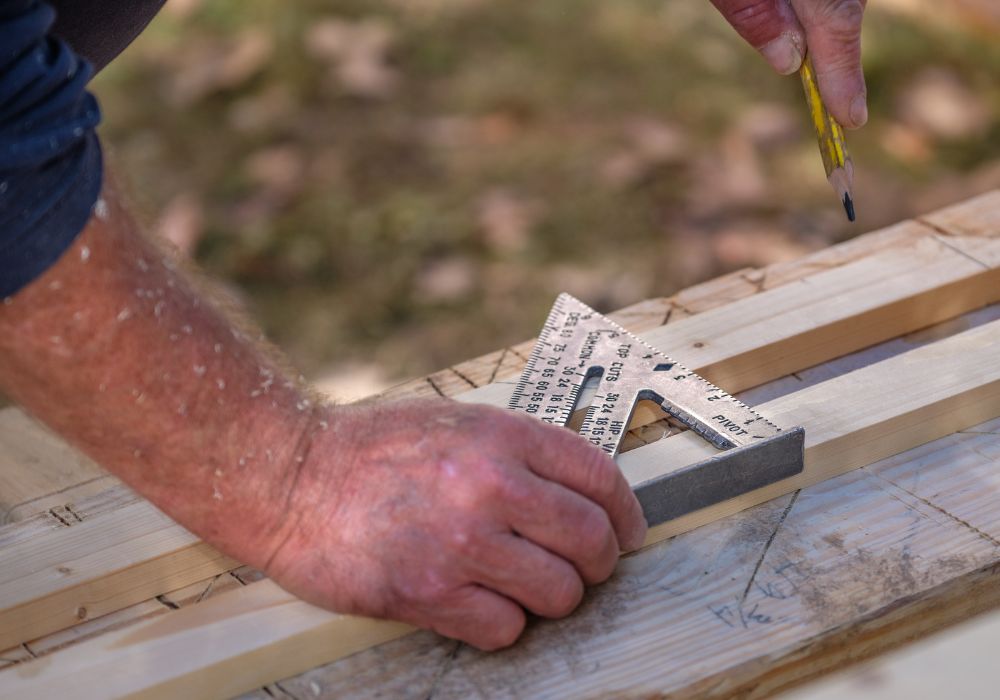
Guiding Dado or Groove Cuts
For projects requiring dado or groove cuts, the speed square serves as a helpful guide. Position the square along the cut line, then guide your router or saw along its edge. This ensures the cut remains straight and even, which is essential for joints or recessed designs.
Tips for Using a Speed Square Effectively
- Always check that your speed square is clean and free of debris before use to ensure accurate measurements.
- Hold the square firmly against your material to avoid slipping, especially when using it as a saw guide.
- Use a high-quality speed square made of aluminum or steel for durability and precision, especially for heavy-duty tasks.
- When cutting miters, use the degree scale on the speed square to mark precise angles, ensuring a perfect fit for corner joints or decorative trims.
- A carpenter’s pencil works well with the notches and edges of a speed square, offering better control for marking straight or angled lines.
- For repetitive tasks like marking multiple boards, the speed square ensures uniform measurements and cuts across all pieces.
- Attach a small speed square to your tool belt or keep it close to your workspace. Its lightweight design makes it easy to carry and use frequently during projects.
The speed square is a versatile and reliable tool for any DIY project. From marking angles to guiding saw cuts, its applications are vast and invaluable. Knowing how to use a speed square properly can improve the accuracy and quality of your work. Whether you’re marking wood for a pocket hole jig or laying out stair stringers, this tool makes every step of the process easier. With practice, you’ll find it to be an essential part of your DIY toolkit.
Advanced Applications
A speed square isn’t just a basic measuring tool—it offers a range of advanced applications that make it invaluable for more complex DIY projects. By understanding these advanced uses, you can maximize the efficiency and precision of your work. Below are the advanced ways to use a speed square and how they can benefit your DIY projects.
Laying Out Rafters for Roof Construction
One of the primary uses of a speed square is in roof framing, where it helps lay out rafters with precision. The degree scale on the hypotenuse allows you to mark the angles needed for plumb cuts (vertical) and seat cuts (horizontal).
To do this, start by identifying the roof pitch, often expressed as a ratio (e.g., 6:12). Place the pivot point of the square at the edge of the wood and rotate it until the desired pitch aligns with the edge. Mark the angle, then repeat for the opposite side.
This ensures your rafters are cut accurately, maintaining the structural integrity of your roof.
Crafting Stair Stringers
Designing and cutting stair stringers is another advanced application of the speed square. Stringers require precise measurements for rise (vertical height of a step) and run (horizontal depth of a step).
Use the speed square to measure each step’s rise and run by aligning it with the edge of the wood and marking the desired dimensions. Repeat the process down the length of the stringer. The result is a perfectly measured guide for cutting steps that are consistent and safe to use.
Calculating Angles for Miter Cuts
Miter cuts are essential for DIY projects involving decorative molding, trim, or picture frames. A speed square provides a built-in protractor to simplify this process.
To find the angle, place the pivot point at the material’s edge and adjust the square until the desired degree on the scale aligns with the edge. Mark the angle and use it as a guide for your saw cuts. This ensures seamless joints and professional-looking results.
Using the Speed Square as a Protractor
Beyond basic angles, a speed square can be used as a full-fledged protractor for marking and measuring any angle. This is particularly useful for projects that require custom angles, such as creating unique geometric patterns or cutting unusual shapes.
To use it as a protractor, align the pivot point with the edge of your material and rotate the square to the desired angle. Mark along the hypotenuse, and you have a precise angle ready for cutting or assembly.

Guiding Dado or Groove Cuts
Dado and groove cuts are common in woodworking, especially for joinery or shelving projects. A speed square can serve as a guide for these precise cuts.
Secure your material and position the speed square along the cut line. Use its straight edge to guide your router or saw, ensuring a clean and even cut. This technique is invaluable for creating strong joints or fitting shelves securely into place.
Marking for Rip Cuts
Rip cuts, which involve cutting wood lengthwise, require consistent alignment. The notches on a speed square make it easy to scribe parallel lines for these cuts.
Insert your pencil into the desired scribe notch, place the square’s lip against the edge of the wood, and slide it along while maintaining steady pressure. This ensures the line stays parallel to the edge, resulting in accurate rip cuts every time.
Using the Speed Square for Compass Work
You can turn your speed square into a makeshift compass for drawing circles or arcs. Attach a pencil to one end of the square with a piece of tape or a rubber band. Hold the pivot point steady on your material and rotate the square to create a circular or arched shape.
This is ideal for projects like designing tabletops, crafting curved furniture pieces, or adding decorative details to your work.
Checking for Warp or Bow in Materials
Warped or bowed wood can ruin a project if not addressed early. A speed square is an effective tool for checking the flatness of materials.
Lay the square flat against the surface of your wood. If there’s a noticeable gap between the square and the material, the wood is either warped or bowed. Identifying this early helps you adjust your cuts or choose alternative materials.
Making Precise Pocket Hole Jig Setups
A speed square ensures precise alignment when using a pocket hole jig. Before drilling, check that your material is square by placing the speed square along its edge. Align the jig to ensure your pocket holes are evenly spaced and drilled at the correct angle.
This attention to detail results in stronger joints and a more professional finish in your DIY furniture or cabinetry projects.
Creating Custom Templates
For repetitive projects, a speed square can be used to create templates for cutting or drilling. Mark your desired measurements and angles on a piece of scrap wood or cardboard. Use the square to draw precise guides, then cut out the template.
Templates save time and ensure uniformity, especially for large-scale projects or multiple identical pieces.
The speed square’s advanced applications make it an indispensable tool for serious DIYers and professionals. From crafting stair stringers to laying out rafters and guiding dado cuts, its versatility extends far beyond basic measurements. Understanding and mastering these advanced uses allows you to tackle complex projects with precision and confidence. Whether you’re framing a roof or creating intricate woodworking designs, the speed square will help bring your vision to life.
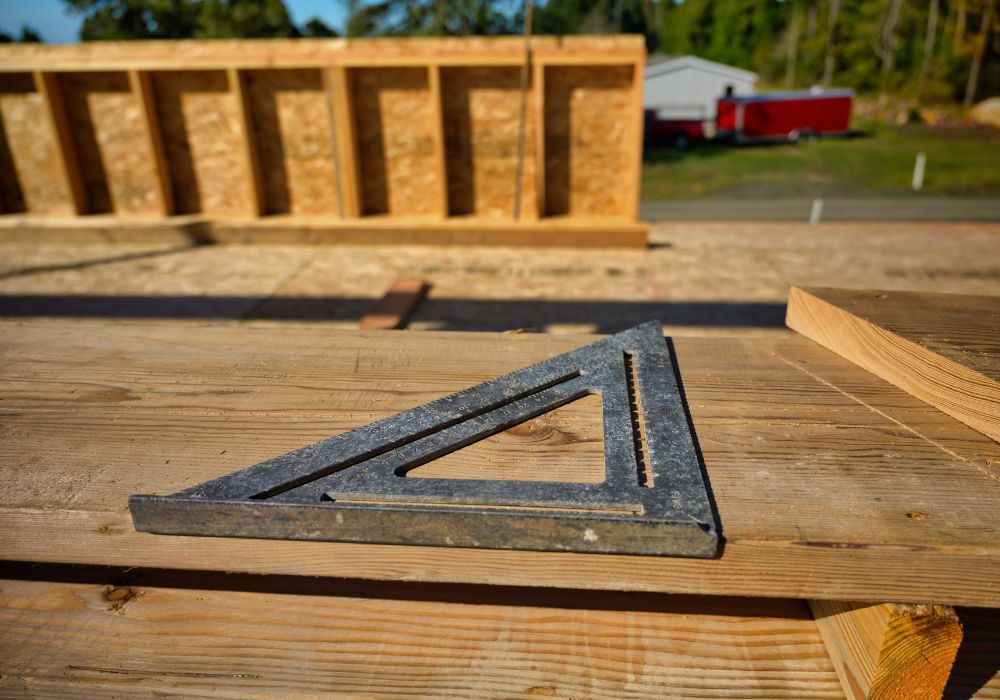
Common Mistakes in Using The Speed Square
Even though the speed square is a straightforward tool, improper use can lead to errors that affect the outcome of your projects. Recognizing common mistakes and learning how to avoid them will help you achieve more accurate and professional results.
- Not Keeping the Square Flush with the Material: If the lip of the speed square isn’t pressed firmly against the material’s edge, your measurements and marks may be off. This can result in crooked lines or imprecise angles.
- How to Avoid: Always double-check that the square is flush against the edge before marking or cutting.
- Misreading the Degree Scale: The degree scale can be confusing for beginners, leading to incorrect angle measurements. This is especially problematic for tasks like cutting rafters or molding.
- How to Avoid: Take time to familiarize yourself with the markings on the degree scale. Practice on scrap wood to ensure you’re comfortable with reading and aligning the angles.
- Using a Damaged or Warped Speed Square: A bent or warped square can result in inaccurate measurements and marks. This often happens if the tool is dropped or subjected to heavy impacts.
- How to Avoid: Inspect your speed square regularly for signs of damage. Replace it if it’s bent or no longer aligns correctly.
- Failing to Secure the Material Before Cutting: Failing to secure the material when using a speed square as a saw guide can cause the square to shift, resulting in uneven cuts.
- How to Avoid: Clamp your material securely to your work surface before cutting. Hold the square firmly in place while guiding the saw.
- Neglecting to Account for Kerf Width: The kerf (the width of the cut made by the saw blade) can throw off your measurements if not accounted for, especially for precise cuts.
- How to Avoid: Factor in the kerf when measuring and marking. Place the blade on the waste side of your marked line to preserve the correct dimensions.
- Overlooking Scribe Notches for Parallel Lines: Many users forget about the scribe notches along the ruler edge of the speed square, missing out on an easy way to mark parallel lines.
- How to Avoid: Familiarize yourself with the tool’s features. Use the notches to quickly and accurately draw parallel lines for your projects.
- Improperly Measuring Roof Pitch: Misaligning the square when measuring roof pitch can lead to inaccurate calculations, affecting the structure’s design and stability.
- How to Avoid: Ensure the square’s pivot point is properly placed, and double-check your readings before marking or cutting.
- Using the Wrong Speed Square Size: Choosing a square that’s too small or too large for your material can lead to inaccurate measurements or difficulty handling the tool.
- How to Avoid: Select the appropriate size for your project. A 7-inch square is ideal for smaller projects, while a 12-inch square is better for larger materials.
- Ignoring Tool Maintenance: A dirty or rusty speed square can make it difficult to see markings clearly or keep the tool flush with your material.
- How to Avoid: Clean your speed square regularly and store it in a dry place to prevent rust. Periodically check for debris before use.
Avoiding these common mistakes will help you maximize the accuracy and efficiency of your speed square, ensuring successful results in every DIY project.
Conclusion
The speed square is an indispensable tool for DIY enthusiasts, offering versatility and precision for a wide range of projects. Mastering its uses, from marking accurate angles to guiding straight cuts, can significantly improve your craftsmanship. By avoiding common mistakes and practicing advanced techniques, you can fully leverage this tool to bring your creative ideas to life.
What kind of projects can you do with a speed square? Check out our outdoor DIY project guide for summer for inspiration!

